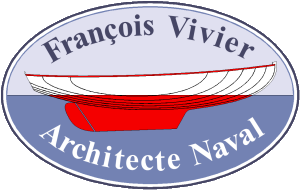I give here some definition related to the boats characteristics as they are used on this site:
Length
The length is the hull length, as defined by ISO 8666 standard, including all structural parts but excluding removable items: rudder, bowsprit, etc…
Breadth (or beam)
The breadth is measured “outside planking”. This means that the rub-rail is not included. The aim is to give a relevant dimension regarding boat stability. Generally, add 20 to 40 mm to get the maximum breadth or beam.
We also give the waterline breadth. A narrow waterline results in good boat under oars or by light wind. A wide waterline results in a more stable hull.
Light weight
The light weight is close to the ISO 8666 definition. It is the weight of the boat ready to sail including rig and basic sail set, the motor of recommended power (not maximum), anchor and line, basic mooring equipment. The water ballast, if any, is empty. For sail and oar boats, there is no motor but oars are included. If there is several rig option, the simpler is considered. Note that the boat weight depends on timber choice and may differ from the given one. It is common that the weight indicated by boats manufacturers and published in yachting magazines is the weight of the hull only and sometimes strongly underestimated. Therefore, I invite you to exercise discernement when comparing my boats weights with other boats.
Empty weight (without rig and/or motor)
For small boats, I indicate the empty weight, being the weight to be handled when all loose items are removed: mast, spars and sails, outboard motor, oars, dagger-board, anchor and mooring equipment….
Building time
It is difficult to give an estimate of the time of construction, so much this one varies from one builder to another, according to the experience possibly gained during former constructions. The tools you have at disposal and you are able to master influence the working time. Some boats are true works of art, others are rather of simple and rustic style. To build yourself a boat supposes that you are looking mainly for the satisfaction of a beautiful work, without being too much worried by time constraint.
Given construction times are therefore indicative. They correspond to a good handyman, who subcontracts the cutting of timber , buy the plywood kit when it exists. In other conditions, the building time may be doubled. The building time is complete, including painting, rigging, fitting ….
Design categories
My boats are designed in compliance with the requirements of the European directive on recreative boats. The recommended maximum crew for each category is given. The definition of these categories is pointed out below:
- Category B (Offshore): Designed for offshore voyages where conditions up to, and including, wind force 8 and significant wave heights up to, and including, 4 m may be experienced.
- Category C (Inshore): designed for trips in coastal waters, large bays, estuaries, lakes and rivers where conditions up to, and including, wind force 6 and significant wave heights up to, and including, 2 m may be experienced.
- Category D (Sheltered waters): designed for voyages in close coastal waters, small bays, lakes, rivers and canals where conditions up to and including wind force 4 and maximum wave heights up to and including 0,3 m may be experienced.
- Note 1: The significant wave height is the mean height of the highest one third of the waves, which approximately corresponds to the wave height estimated by an experienced observer. Some waves will be double this height.
- Note 2: The Beaufort wind scale is based on the measurement on an average wind speed over a 10 minutes period. Therefore there can be gusts with a speed 50% higher
